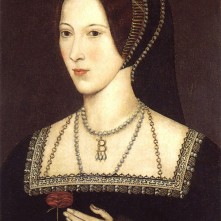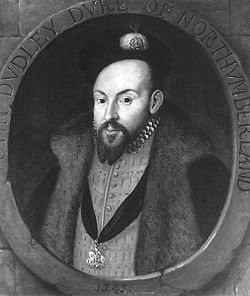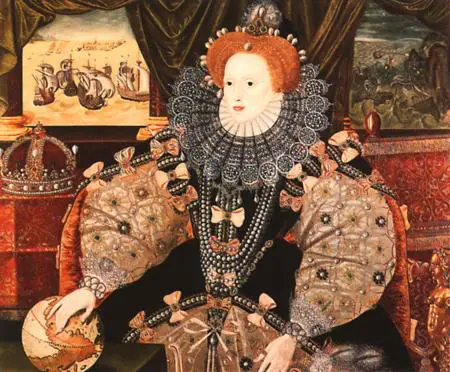24 August
1507 – Death of Cecily, Viscountess Welles (Cecily of York), third daughter of Edward IV and Elizabeth Woodville, at Hatfield, Hertfordshire. She was buried at “the friars”, but it is not known what religious house the record was referring to.
1549 – Death of Sir Wymond Carew, administrator. Carew served Henry VIII as Deputy Receiver-General of the Duchy of Cornwall, as Receiver-General to Queens Jane Seymour and Anne of Cleves, as Treasurer to Queen Catherine Parr, and as Treasurer of the Court of First Fruits and Tenths.
1561 – Birth of Thomas Howard, 1st Earl of Suffolk, naval officer and administrator. Howard was St the eldest son of Thomas Howard, 4th Duke of Norfolk, and Margaret Dudley. Howard served Elizabeth I as Vice-Admiral in the 1596 Cadiz expedition and the 1597 voyage to the Azores, and as Constable of the Tower of London. He went on to have a distinguished career under James I until his fall in 1619.
1572 - The St Bartholmew's Day Massacre took place. An estimated 3,000 French Protestants (Huguenots) were massacred in Paris, and a further estimated 7,000 in the provinces. Click here for more information.
1587 – Death of Richard Barnes, Bishop of Durham. He was buried at Durham Cathedral, in the choir.
1595 – Death of Thomas Digges, mathematician, astronomer, soldier and member of Parliament. Digges is known as the first man to expound the Copernican system in English, and one of the first to put forward the idea of an infinite universe with an infinite number of stars.
25 August
1482 - Death of Margaret of Anjou, wife of Henry VI. Click here for more information on her.
1526 - Birth of Mildred Cecil, Lady Burghley. She was the daughter of Sir Anthony Cooke, a scholar and the man who became Edward VI's tutor, and his wife, Anne Fitzwilliam. Cooke educated his daughter himself, at home, providing her with the classical education usually reserved for boys. Mildred is known not only for being the second wife of William Cecil, 1st Baron Burghley and Elizabeth I's trusted minister, but for her humanist education, intelligence and fluency in Greek and Latin. Mildred also translated several works, including a Greek sermon by Basil the Great. Her huge library contained works in Latin, Greek, French and English, covering the subjects of religion, literature, history and medicine. At her death in 1589, on her instruction, many of her books were given to educational institutions, and seventeen of her books are housed today at Hatfield House.
1538 – Death of Thomas Starkey, humanist and political theorist. He was buried in the chancel of St Mary's, North Petherton, Somerset. Starkey is known for his works, “Dialogue between Pole and Lupset” and “An Exhortation to the People Instructing them to Unity and Obedience”.
1540 – Date traditionally given for the birth of Lady Katherine Grey, daughter of Henry Grey, 1st Duke of Suffolk, and his wife, Frances (née Brandon), at Bradgate Park. Katherine was one of the sisters of Lady Jane Grey.
1549 – Robert Kett, leader of the rebels in Kett's Rebellion, launched an attack on the south side of Norwich and burned a number of buildings.
1554 – Death of Thomas Howard, 3rd Duke of Norfolk, at Kenninghall.
1557 – Death of Mary Howard (née Fitzalan), Duchess of Norfolk, at Arundel House, London. It is thought that she died of complications after childbirth. Mary was buried in St Clements without Temple Bar.
1558 – Death of John Robins, clergyman, mathematician and astrologer, at Windsor. He was buried in St George's Chapel, Windsor Castle. It is thought that Robins tutored Henry VIII in the subjects of mathematics and astronomy.
1559 – Death of Sir Thomas Cawarden, courtier and Master of Revels to Henry VIII, Edward VI and Mary I, at Horsley. He was buried in Bletchingley church.
26 August
1533 - A heavily pregnant Queen Anne Boleyn took to her chamber at Greenwich Palace in preparation for the birth of her first child.
1539 – Death of Piers Butler, 1st Earl of Ossory and 8th Earl of Ormond, Lord Deputy of Ireland and a man known as “Red Piers”. He died at Kilkenny Castle and was laid to rest in the chancel of St Canice's Cathedral, Kilkenny.
1549 – The Earl of Warwick received 1,000 mercenaries as reinforcements to fight the rebels of Kett's Rebellion. Click here to read more about Kett's Rebellion.
1552 – Death of Sir Clement Smith, administrator, brother-in-law of Jane Seymour and Lord Treasurer's Remembrancer from 1539 until his death. He died at Little Baddow in Essex.
1555 – Mary I and her husband, Philip of Spain, departed from Whitehall in preparation for Philip's return to the Low Countries.
1570 – Death of Thomas Thirlby, Bishop of Westminster and of Ely, at Lambeth Palace. He was deprived of his sees in 1559 due to his Catholic sympathies, and then imprisoned in the Tower in 1560. He was eventually released into house arrest at Lambeth, where he spent his last years. Thirlby was buried in the parish church at Lambeth.
1613 – Death of George Owen of Henllys, Welsh antiquary, author, naturalist, Deputy Lieutenant of Pembrokeshire and High Sheriff of Pembrokeshire, in Haverfordwest. He was buried at Nevern church. His works include “The Description of Penbrokshire”.
27 August
1549 - The Battle of Dussindale took place, ending Kett's Rebellion in Norfolk. The mercenaries John Dudley, Earl of Warwick, had received the day before forced Kett and his rebels to move from Mousehold to the valley of Dussindale by cutting off their supply lines. It was in this valley – the actual location is not known – that a bloody battle took place on 27th August. There were heavy losses on both sides, with reports ranging from 1,000 to 10,000 rebels being killed. Warwick was victorious, and the rebellion was over.
1557 – The storming of St Quentin by English and Imperial forces. Admiral de Coligny and his French troops, numbering only a thousand, were overcome by around 60,000 soldiers, and St Quentin fell. Henry Dudley, the youngest son of the late John Dudley, Duke of Northumberland, was killed by a cannonball during the storming.
1590 – Death of Pope Sixtus V at Rome.
1610 – Funeral of Lady Anne Bacon (née Cooke), mother of Sir Francis Bacon, at St Michael's Church, near St Albans. Anne was the daughter of Sir Anthony Cooke, and was known for her translation of John Jewel's “Apologie of the Church of England”.
28 August
1550 – Death of Thomas Magnus, administrator, Archdeacon of the East Riding of Yorkshire, member of the King's Council and diplomat, at Sessay in the North Riding of Yorkshire. He was also buried there.
1551 - Lord Chancellor Richard Rich, Sir Anthony Wingfield and Sir William Petre went to Copthall in Essex to see Edward VI's half-sister Mary. The purpose of their visit was to deliver the King's order that Mary and her household should desist from celebrating the Catholic mass, and that Wingfield should replace Robert Rochester, whom Edward's council had removed, as Mary's comptroller. Mary refused to obey them and they were forced to leave, having failed their mission.
1553 – Death of Sir John Harington, administrator, in Bishopsgate, London. He was buried in Exton. Harington served Henry VIII as Esquire of the Body, Treasurer of War (1542 and 1543), Vice-Treasurer of the army for the 1544 French campaign and Treasurer of the expedition to France (1546).
1583 – Burial of William Latymer, Chaplain to Queen Anne Boleyn, Dean of Peterborough, chaplain to Elizabeth I and author of the “Cronickille of Anne Bulleyne”, a biography of Anne Boleyn. He was buried in Peterborough Cathedral.
1588 – Execution of William Dean, Roman Catholic priest and martyr, by hanging at Mile End Green, Middlesex. He was found guilty of high treason for being a Catholic priest.
1588 – Execution of Franciscan friar and martyr, Thomas Felton, near Brentford, Middlesex. He was hanged, drawn and quartered for his beliefs, and for proclaiming that he could not accept a woman as supreme head of the Church.
1609 – Death of Sir Francis Vere (de Vere), soldier. He served in the English army in the Low Countries, and also in the 1596 Cadiz expedition. He was buried in Westminster Abbey.
29 August
1503 – Death of Oliver King, Bishop of Bath and Wells, diplomat, former Secretary to Edward V and Registrar of the Order of the Garter.
1538 – Arrest of Geoffrey Pole on suspicion of being in contact with his brother, Cardinal Reginald Pole, who had denounced the King and his policies in his treatise, Pro ecclesiasticae unitatis defensione.
1582 – Death of Sir Thomas Offley, Mayor of London, in London. He was buried in the church of St Andrew Undershaft.
1583 – Death of Maurice Browne, courtier, adventurer and mariner. Browne captained The Swallow and then The Delight on a venture to colonize North America in 1583. The venture failed and Browne, and the voyage leader, Sir Humphrey Gilbert, both died.
1584 – Death of Lucas de Heere, the Flemish painter and poet, probably in Paris. His works included “Solomon and Sheba” (1559) in which de Heere gave Solomon the face of Philip II of Spain.
1599 – Death of Henry Charteris, Scottish printer and bookseller.
30 August
1501 – Death of Thomas Grey, 1st Marquis of Dorset, courtier and son of Elizabeth Woodville by her first husband, Sir John Grey of Groby. Dorset was buried in the collegiate church of Astley in Warwickshire.
1525 - The Treaty of the More, negotiated by Cardinal Thomas Wolsey, was agreed by Henry VIII and Louise of Savoy, who was acting as regent while Francis I was imprisoned by Imperial forces. He had been captured at the Battle of Pavia. It was an about-face for Wolsey as he had, in the recent past, been allying England with the Empire, rather than France. By the terms of the treaty, Henry VIII agreed to help secure Francis I's release, and to give up claims to several French territories. In return, France was to award England with a pension of £20,000 per year.
The treaty was known as the Treaty of the More because negotiations took place at Wolsey’s property in Hertfordshire, “The More”.
1534 – Death of Thomas Belchiam, Observant Franciscan friar and Catholic martyr. The twenty-eight year old friar was starved to death at Newgate Prison. Belchiam had allegedly called the King a heretic. It is also alleged that there was an earthquake at the time of his death.
1548 - Mary Seymour, daughter and only child of Catherine Parr, Queen Dowager, and Thomas Seymour, Baron Seymour of Sudeley, was born at Sudeley Castle in Gloucestershire. Mary disappears from the records before she even reached the age of two and her fate is unknown.
1582 – Death of Richard Curteys, Bishop of Chichester. He was buried at Chichester Cathedral. In 1600, a collection of ten of his sermons on Psalm 25 was published as “The Care of a Christian Conscience”.
1595 – Death of William Vaux, 3rd Baron Vaux, English peer and Catholic recusant. He was imprisoned in Elizabeth I's reign for his Catholic faith and for harbouring Edmund Campion, a Jesuit priest.
1596 – Death of George Gower, English portrait painter and Sergeant Painter to Elizabeth I, in the parish of St Clement Danes in London. He was buried at the church there.









Leave a Reply